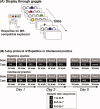Interleaved practice enhances skill learning and the functional connectivity of fronto-parietal networks
- PMID: 22359276
- PMCID: PMC6870452
- DOI: 10.1002/hbm.22009
Interleaved practice enhances skill learning and the functional connectivity of fronto-parietal networks
Abstract
Practice of tasks in an interleaved order generally induces superior learning compared with practicing in a repetitive order, a phenomenon known as the contextual-interference (CI) effect. Increased neural activity during interleaved over repetitive practice has been associated with the beneficial effects of CI. Here, we used psychophysiological interaction (PPI) analysis to investigate whether the neural connectivity of the dorsal premotor (PM) and the dorsolateral prefrontal (DLPFC) cortices changes when motor sequences are acquired through interleaved practice. Sixteen adults practiced a serial reaction time task where a set of three 4-element sequences were arranged in a repetitive or in an interleaved order on 2 successive days. On Day 5, participants were tested with practiced sequences to evaluate retention. A within-subjects design was used so that participants practiced sequences in the other condition (repetitive or interleaved) 2-4 weeks later. Functional magnetic resonance images were acquired during practice and retention. On Day 2 of practice, there was greater inter-regional functional connectivity in the interleaved compared with the repetitive condition for both PM-seeded and DLPFC-seeded connectivity. The increased functional connectivity between both seeded regions and sensorimotor cortical areas correlated with the benefit of interleaved practice during later retention. During retention, a significant PPI effect was found in DLPFC-seeded connectivity, with increased DLPFC-supplementary motor area connectivity correlated with the benefits of interleaved practice. These data suggest that interleaved practice benefits learning by enhancing coordination of sensorimotor cortical regions, and superior performance of sequences learned under CI is characterized by increased functional connectivity in frontal cortex.
Copyright © 2012 Wiley Periodicals, Inc.
Figures






Similar articles
-
Enhanced motor learning in older adults is accompanied by increased bilateral frontal and fronto-parietal connectivity.Brain Connect. 2012;2(2):56-68. doi: 10.1089/brain.2011.0059. Epub 2012 Jun 11. Brain Connect. 2012. PMID: 22512355
-
Brain-behavior correlates of optimizing learning through interleaved practice.Neuroimage. 2011 Jun 1;56(3):1758-72. doi: 10.1016/j.neuroimage.2011.02.066. Epub 2011 Mar 2. Neuroimage. 2011. PMID: 21376126
-
Age related differences in the neural substrates of motor sequence learning after interleaved and repetitive practice.Neuroimage. 2012 Sep;62(3):2007-20. doi: 10.1016/j.neuroimage.2012.05.015. Epub 2012 May 11. Neuroimage. 2012. PMID: 22584226
-
Benefit of interleaved practice of motor skills is associated with changes in functional brain network topology that differ between younger and older adults.Neurobiol Aging. 2016 Jun;42:189-98. doi: 10.1016/j.neurobiolaging.2016.03.010. Epub 2016 Mar 21. Neurobiol Aging. 2016. PMID: 27143435
-
High contextual interference improves retention in motor learning: systematic review and meta-analysis.Sci Rep. 2024 Jul 10;14(1):15974. doi: 10.1038/s41598-024-65753-3. Sci Rep. 2024. PMID: 38987617 Free PMC article.
Cited by
-
Dorsal premotor activity and connectivity relate to action selection performance after stroke.Hum Brain Mapp. 2016 May;37(5):1816-30. doi: 10.1002/hbm.23138. Epub 2016 Feb 15. Hum Brain Mapp. 2016. PMID: 26876608 Free PMC article.
-
Mechanisms within the Parietal Cortex Correlate with the Benefits of Random Practice in Motor Adaptation.Front Hum Neurosci. 2017 Aug 2;11:403. doi: 10.3389/fnhum.2017.00403. eCollection 2017. Front Hum Neurosci. 2017. PMID: 28824406 Free PMC article.
-
Age-related variability in performance of a motor action selection task is related to differences in brain function and structure among older adults.Neuroimage. 2014 Feb 1;86:326-34. doi: 10.1016/j.neuroimage.2013.10.016. Epub 2013 Oct 12. Neuroimage. 2014. PMID: 24125791 Free PMC article.
-
Differential Training Facilitates Early Consolidation in Motor Learning.Front Behav Neurosci. 2016 Oct 21;10:199. doi: 10.3389/fnbeh.2016.00199. eCollection 2016. Front Behav Neurosci. 2016. PMID: 27818627 Free PMC article.
-
Enhancing perceptual, attentional, and working memory demands through variable practice schedules: insights from high-density EEG multi-scale analyses.Cereb Cortex. 2024 Nov 5;34(11):bhae425. doi: 10.1093/cercor/bhae425. Cereb Cortex. 2024. PMID: 39503244 Free PMC article.
References
-
- Alexander GE, Crutcher MD ( 1990): Functional architecture of basal ganglia circuits: Neural substrates of parallel processing. Trends Neurosci 13: 266–271. - PubMed
-
- Battig WF, Berry JK ( 1966): Effects of number and similarity of pretraining alternatives on paired‐associate performance on pretrained and new items under correction and noncorrection procedures. J Exp Psychol 72: 722–730. - PubMed
-
- Ben‐Shaul Y, Drori R, Asher I, Stark E, Nadasdy Z, Abeles M ( 2004): Neuronal activity in motor cortical areas reflects the sequential context of movement. J Neurophysiol 91: 1748–1762. - PubMed
-
- Bortoletto M, Cunnington R ( 2010): Motor timing and motor sequencing contribute differently to the preparation for voluntary movement. Neuroimage 49: 3338–3348. - PubMed
Publication types
MeSH terms
Substances
Grants and funding
LinkOut - more resources
Full Text Sources

